From the Trenches
No Dice Left Unturned
By TRACY E. ROBEY
Monday, April 09, 2018
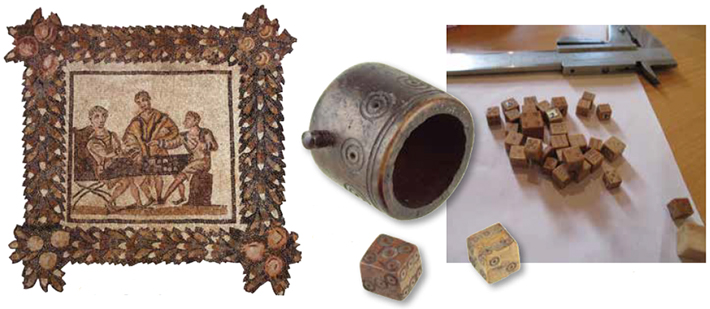
Dice generally get mentioned only in passing in excavation reports, but researchers Jelmer W. Eerkens and Alex de Voogt say that changes in dice design can reflect shifting mentalities. According to Eerkens, an anthropologist at the University of California, Davis, “It takes assembling large numbers of dice to see the broader patterns,” which is why the team visited dozens of museums to construct a historical dice database.
After comparing dice from ancient Roman, medieval, and Renaissance sites in the Netherlands, Eerkens found that they became standardized over time, shifting from “lopsided and uneven” Roman dice to more cubic designs as of 1250. By 1450, dice were highly standardized in shape with the numbers on opposite sides adding up to seven, inspired by the demand for fair dice with equal probabilities. Knowledge of math had effectively snuffed out the belief that fate, dictated by the gods, determined outcomes. With the help of the dice database—to be released publicly in the future—archaeologists will also be able to use dice to help date site layers.
Afterlife Under the Waves
By ZACH ZORICH
Monday, April 09, 2018
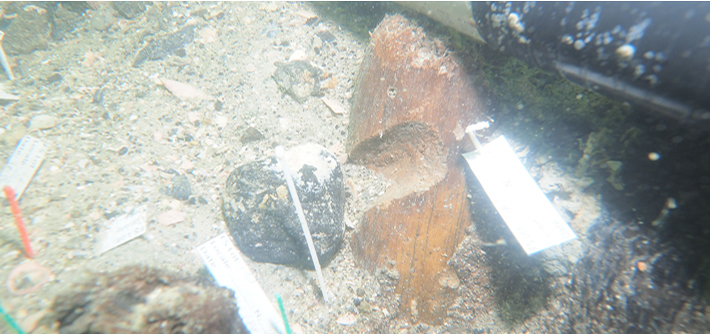
Twenty-one feet beneath the waves near Florida’s Manasota Key, divers have found a 7,200-year-old burial ground. The site appears to have been a freshwater pond when it was in use, but rising sea levels over the millennia have submerged it. So far, the bones of at least six individuals have been identified, as well as pieces of cordage, fabric, and some carved wooden posts that were used to hold the bodies of the deceased in place at the bottom of the pond. This was a common burial practice in that part of Florida at the time. Wave action and the force of hurricanes were thought to make the underwater environment too harsh to preserve archaeological sites, says Ryan Duggins, underwater archaeology supervisor of Florida’s Bureau of Archaeological Research, but the Manasota Key site shows that Florida’s Gulf Coast may hold many more. According to Duggins, “The continental shelf is kind of the next frontier of archaeology.”
The Pirate Book Club
By DANIEL WEISS
Monday, April 09, 2018
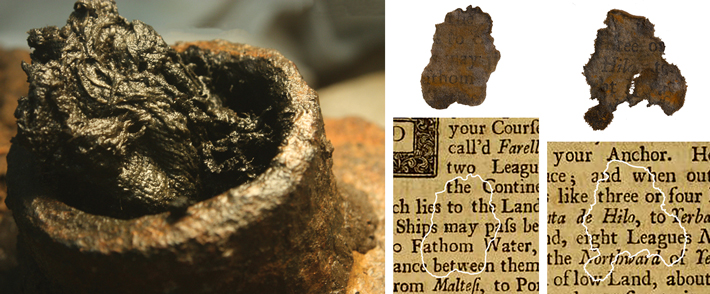
It is extremely rare to find paper in a shipwreck, but a number of small scraps were retrieved from the wreckage of Queen Anne’s Revenge, the pirate Blackbeard’s flagship, which ran aground off the North Carolina coast in 1718. Now, based on words printed on the fragments, researchers have determined that they came from a 1712 narrative of a round-the-world voyage. It’s unclear whether Blackbeard or his men actually read Captain Edward Cooke’s A Voyage to the South Sea, and Round the World, Perform’d in the Years 1708, 1709, 1710 and 1711 between bouts of plundering merchant ships on the way from Africa to the Caribbean. After all, the paper was found amid sludge removed from the chamber of a breech-loading cannon. But Queen Anne’s Revenge project conservator Kimberly Kenyon notes that tales of South Sea voyages were wildly popular with the reading public at the time—and may well have been among pirates, too.
Alternative Deathstyles
By ZACH ZORICH
Monday, April 09, 2018

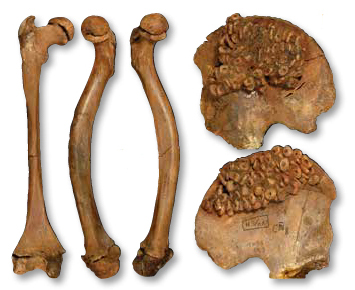 About 34,000 years ago the hunter-gatherers living on what are now the plains of Russia east of Moscow are known to have had a complex society with well-defined social roles. Erik Trinkaus of Washington University in St. Louis and Alexandra P. Buzhilova of Lomonosov Moscow State University have been reanalyzing burials from the site of Sunghir, which was excavated in the 1960s. In 2017 their most intriguing discoveries came from a grave containing two adolescent boys who had been buried head to head. This grave held more than 10,000 beads and 16 spears made of mammoth ivory, as well as several ivory disks and a pendant with a carving of a mammoth on it. Analysis of the skeletons shows that both boys suffered from physical abnormalities. One boy had severely shortened and bowed leg bones. The other seems to have suffered from a deformation around the mouth and muscle weakness. Both, though, were physically active. To Trinkaus the fact that these boys were buried with so many luxury goods confirms that they lived in a complex society where individuals were born into specific roles within the group. He says, “There is diversity in death, which should reflect diversity in the living.”
About 34,000 years ago the hunter-gatherers living on what are now the plains of Russia east of Moscow are known to have had a complex society with well-defined social roles. Erik Trinkaus of Washington University in St. Louis and Alexandra P. Buzhilova of Lomonosov Moscow State University have been reanalyzing burials from the site of Sunghir, which was excavated in the 1960s. In 2017 their most intriguing discoveries came from a grave containing two adolescent boys who had been buried head to head. This grave held more than 10,000 beads and 16 spears made of mammoth ivory, as well as several ivory disks and a pendant with a carving of a mammoth on it. Analysis of the skeletons shows that both boys suffered from physical abnormalities. One boy had severely shortened and bowed leg bones. The other seems to have suffered from a deformation around the mouth and muscle weakness. Both, though, were physically active. To Trinkaus the fact that these boys were buried with so many luxury goods confirms that they lived in a complex society where individuals were born into specific roles within the group. He says, “There is diversity in death, which should reflect diversity in the living.”
A Night Out in Leicestershire
By DANIEL WEISS
Monday, April 09, 2018
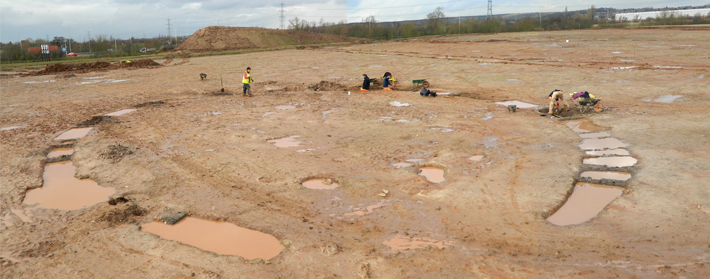
During the Iron Age, people in what is now Leicestershire, in the Midlands region of England, generally lived in village-like settlements devoted to farming. But the discovery of 11 complete or nearly complete cauldrons—along with a scattering of other artifacts—buried at the site of Glenfield Park and thought to date to the third or fourth century B.C. suggests that people from the surrounding area were drawn there to partake in large feasts. “These gatherings may have taken place at significant times of the year—festival times or rites of passage,” says excavation director John Thomas of University of Leicester Archaeological Services. “Feasting is thought to have played an important social role within Iron Age society, and it may have helped bring the wider community together and increased opportunities for social interaction.”
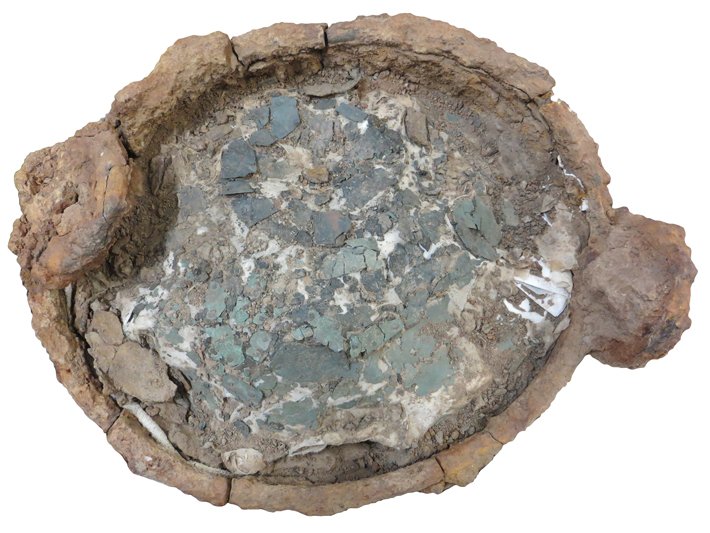 Given the cauldrons’ fragility and size, they were removed from the site in blocks of soil. They were then CT scanned, revealing extensive patching at the bottoms of the copper-alloy bowls, indicating a long history of intensive use. So far, one of the vessels has been excavated in the lab at Museum of London Archaeology. Its base was covered with a thin layer of soot, presumably from the last time it hung over a fire. Thomas says the cauldrons were likely used to serve beef stew, oat porridge, or alcoholic drinks such as mead.
Given the cauldrons’ fragility and size, they were removed from the site in blocks of soil. They were then CT scanned, revealing extensive patching at the bottoms of the copper-alloy bowls, indicating a long history of intensive use. So far, one of the vessels has been excavated in the lab at Museum of London Archaeology. Its base was covered with a thin layer of soot, presumably from the last time it hung over a fire. Thomas says the cauldrons were likely used to serve beef stew, oat porridge, or alcoholic drinks such as mead.
Advertisement
Advertisement
IN THIS ISSUE
From the Trenches
Conquistador Contagion
Off the Grid
Circle of Life
Norwegian Knight
A Night Out in Leicestershire
The Pirate Book Club
Alternative Deathstyles
Afterlife Under the Waves
No Dice Left Unturned
A Mark of Distinction
Early Buddhism in India
A Bronze Age Landmark
Time’s Arrow
We Are Family
World Roundup
Taino DNA, island Etruscans, IRA buttons, gate to the afterlife, and the last wild horses
Artifact
Man of the hours
Advertisement

Recent Issues
-
 May/June 2024
May/June 2024
-
 March/April 2024
March/April 2024
-
 January/February 2024
January/February 2024
-
 November/December 2023
November/December 2023
-
 September/October 2023
September/October 2023
-
 July/August 2023
July/August 2023
-
 May/June 2023
May/June 2023
-
 March/April 2023
March/April 2023
-
 January/February 2023
January/February 2023
-
 November/December 2022
November/December 2022
-
 September/October 2022
September/October 2022
-
 July/August 2022
July/August 2022
-
 May/June 2022
May/June 2022
-
 March/April 2022
March/April 2022
-
 January/February 2022
January/February 2022
-
 November/December 2021
November/December 2021
-
 September/October 2021
September/October 2021
-
 July/August 2021
July/August 2021
-
 May/June 2021
May/June 2021
-
 March/April 2021
March/April 2021
-
 January/February 2021
January/February 2021
-
 November/December 2020
November/December 2020
-
 September/October 2020
September/October 2020
-
 July/August 2020
July/August 2020
-
 May/June 2020
May/June 2020
-
 March/April 2020
March/April 2020
-
 January/February 2020
January/February 2020
-
 November/December 2019
November/December 2019
-
 September/October 2019
September/October 2019
-
 July/August 2019
July/August 2019
-
 May/June 2019
May/June 2019
-
 March/April 2019
March/April 2019
-
 January/February 2019
January/February 2019
-
 November/December 2018
November/December 2018
-
 September/October 2018
September/October 2018
-
 July/August 2018
July/August 2018
-
 May/June 2018
May/June 2018
-
 March/April 2018
March/April 2018
-
 January/February 2018
January/February 2018
-
 November/December 2017
November/December 2017
-
 September/October 2017
September/October 2017
-
 July/August 2017
July/August 2017
-
 May/June 2017
May/June 2017
-
 March/April 2017
March/April 2017
-
 January/February 2017
January/February 2017
-
 November/December 2016
November/December 2016
-
 September/October 2016
September/October 2016
-
 July/August 2016
July/August 2016
-
 May/June 2016
May/June 2016
-
 March/April 2016
March/April 2016
-
 January/February 2016
January/February 2016
-
 November/December 2015
November/December 2015
-
 September/October 2015
September/October 2015
-
 July/August 2015
July/August 2015
-
 May/June 2015
May/June 2015
-
 March/April 2015
March/April 2015
-
 January/February 2015
January/February 2015
-
 November/December 2014
November/December 2014
-
 September/October 2014
September/October 2014
-
 July/August 2014
July/August 2014
-
 May/June 2014
May/June 2014
-
 March/April 2014
March/April 2014
-
 January/February 2014
January/February 2014
-
 November/December 2013
November/December 2013
-
 September/October 2013
September/October 2013
-
 July/August 2013
July/August 2013
-
 May/June 2013
May/June 2013
-
 March/April 2013
March/April 2013
-
 January/February 2013
January/February 2013
-
 November/December 2012
November/December 2012
-
 September/October 2012
September/October 2012
-
 July/August 2012
July/August 2012
-
 May/June 2012
May/June 2012
-
 March/April 2012
March/April 2012
-
 January/February 2012
January/February 2012
-
 November/December 2011
November/December 2011
-
 September/October 2011
September/October 2011
-
 July/August 2011
July/August 2011
-
 May/June 2011
May/June 2011
-
 March/April 2011
March/April 2011
-
 January/February 2011
January/February 2011
Advertisement






